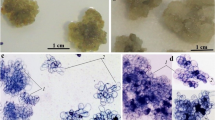Summary
Dwarf and normal pea seedlings were extracted and their gibberellinlike substances bioassayed. The normal peas yield about 8 times as much as the dwarfs of gibberellin-fraction I after Kende and Lang, which is highly effective on normal peas but nearly without effect on dwarfs.
Both cultivars were treated with the inhibitor of gibberellin-synthesis in the fungus Fusarium, chlorocholinchloride (CCC). In red light the normal plants are dwarfed, but in darkness this substance has only a weak inhibiting effect on growth. The inhibition in darkness is of the same magnitude as the effect of CCC on dwarfs growing in red light. A possible explanation for the ineffectiveness of CCC in darkness is that peas need there no gibberellin at all or only very minute amounts for growth.
Zusammenfassung
Keimlinge von Zwerg- und Normalerbsen wurden auf ihren Gibberellingehalt getestet. Die Normalerbsen enthalten etwa achtmal soviel wie die Zwerge von der Gibberellinfraktion I nach Kende und Lang, die auf Normalerbsen stark, auf Zwerge kaum wirkt.
Beide Rassen wurden mit Chlorcholinchlorid, einem Hemmstoff der Gibberellinsynthese bei Fusarium, behandelt. Im Rotlicht werden die normalen Pflanzen verzwergt, doch im Dunkeln hat die Substanz nur einen geringen Effekt. Die Dunkelhemmung ist so groß wie die Hemmung der Zwerge in Rotlicht. Eine mögliche Erklärung für die Unwirksamkeit von CCC im Dunkeln ist, daß die Erbsen im Dunkeln zum Wachstum kein oder nur wenig Gibberellin benötigen.
Similar content being viewed by others
Literatur
Kende, H., and A. Lang: Gibberellins and light inhibition of stem growth in peas. Plant Physiol. 39, 435–440 (1964).
—, H. Ninnemann, and A. Lang: Inhibition of gibberellic acid biosynthesis by Amo 1618 and CCC in Fusarium moniliforme. Naturwissenschaften 50, 599–600 (1963).
Köhler, D.: Kinetische Untersuchungen über die Wirkung eines aus unreifen Samen von Vicia faba isolierten Antigibberellins. Planta (Berl.) 63, 326–343 (1964).
—, and A. Lang: Evidence for substances in higher plants interfering with response of dwarf peas to gibberellin. Plant Physiol. 38, 555–560 (1963).
Phinney, B. O.: Dwarfing genes in Zea mays and their relation to the gibberellins. In: Plant growth regulation, ed. R. M. Klein, p. 489–501. Iowa State College Press 1961.
Author information
Authors and Affiliations
Rights and permissions
About this article
Cite this article
Köhler, D. Über den Gibberellingehalt von Zwerg- und Normalerbsen im Rotlicht und die Wirkung von Chlorcholinchlorid auf das Wachstum der Erbsen. Planta 65, 218–224 (1965). https://doi.org/10.1007/BF00390123
Received:
Issue Date:
DOI: https://doi.org/10.1007/BF00390123




